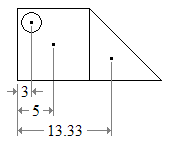Center of mass
|
|
This article includes a list of references, but its sources remain unclear because it has insufficient inline citations. Please help to improve this article by introducing more precise citations where appropriate. (November 2010) |
The center of mass or mass center is the mean location of all the mass in a system. In the case of a rigid body, the position of the center of mass is fixed in relation to the body. In the case of a loose distribution of masses in free space, such as shot from a shotgun or the planets of the solar system, the position of the center of mass is a point in space among them that may not correspond to the position of any individual mass. The use of the mass center often allows the use of simplified equations of motion, and it is a convenient reference point for many other calculations in physics, such as angular momentum or the moment of inertia. In many applications, such as orbital mechanics, objects can be replaced by point masses located at their mass centers for the purposes of analysis.
The term center of mass is often used interchangeably with center of gravity, but they are physically different concepts. They happen to coincide in a uniform gravitational field, but where gravity is not uniform, center of gravity refers to the mean location of the gravitational force acting on a body. This results in small but measurable gravitational torque that must be accounted for in the operation of artificial satellites.
Barycenter or barycentre may also refer to the center of mass.
The center of mass of a body does not generally coincide with its geometric center, and this property can be exploited. Engineers try to design a sports car's center of mass as low as possible to make the car handle better. When high jumpers perform a "Fosbury Flop", they bend their body in such a way that it is possible for the jumper to clear the bar while his or her center of mass does not.[1]
The center of momentum frame is an inertial frame defined as the inertial frame in which the center of mass of a system is at rest. A specific center of momentum frame in which the center of mass is not only at rest, but also at the origin of the coordinate system, is sometimes called the center of mass frame, or center of mass coordinate system.
Contents |
[edit] Definition
The center of mass  of a system of particles is defined as the average of their positions,
of a system of particles is defined as the average of their positions,  , weighted by their masses, mi:
, weighted by their masses, mi:
For a continuous distribution with mass density  and total mass M, the sum becomes an integral:
and total mass M, the sum becomes an integral:
If an object has uniform density then its center of mass is the same as the centroid of its shape.
[edit] Examples
- The center of mass of a two-particle system lies on the line connecting the particles (or, more precisely, their individual centers of mass). The center of mass is closer to the more massive object; for details, see below.
- The center of mass of a uniform ring is at the center of the ring; outside the material that makes up the ring.
- The center of mass of a uniform solid triangle lies on all three medians and therefore at the centroid, which is also the average of the three vertices.
- The center of mass of a uniform rectangle is at the intersection of the two diagonals.
- In a spherically symmetric body, the center of mass is at the geometric center.[2] This approximately applies to the Earth: the density varies considerably, but it mainly depends on depth and less on the latitude and longitude coordinates.
- More generally, for any symmetry of a body, its center of mass will be a fixed point of that symmetry.
[edit] History
The concept of center of mass was first introduced by the ancient Greek physicist, mathematician, and engineer Archimedes of Syracuse. Archimedes showed that the torque exerted on a lever by weights resting at various points along the lever is the same as what it would be if all of the weights were moved to a single point — their center of mass. In work on floating bodies he demonstrated that the orientation of a floating object is the one that makes its center of mass as low as possible. He developed mathematical techniques for finding the centers of mass of objects of uniform density of various well-defined shapes, in particular a triangle, a hemisphere, and a frustum (of a circular paraboloid).
Newton's second law is refomulated with respect to the center of mass in Euler's first law.
[edit] Derivation of center of mass
The following equations of motion assume that there is a system of particles governed by internal and external forces. An internal force is a force caused by the interaction of the particles within the system. An external force is a force that originates from outside the system, and acts on one or more particles within the system. The external force need not be due to a uniform field.
For any system with no external forces, the center of mass moves with constant velocity. This applies for all systems with classical internal forces, including magnetic fields, electric fields, chemical reactions, and so on. More formally, this is true for any internal forces that satisfy the weak form of Newton's Third Law.
The total momentum for any system of particles is given by
Where M indicates the total mass, and vcm is the velocity of the center of mass. This velocity can be computed by taking the time derivative of the position of the center of mass.
An analogue to Newton's Second Law is
Where F indicates the sum of all external forces on the system, and acm indicates the acceleration of the center of mass.
Letting the total internal force of the system.
where M is the total mass of the system and  is a vector yet to be defined, since:
is a vector yet to be defined, since:
and
then
We therefore have a vectorial definition for center of mass in terms of the total forces in the system. This is particularly useful for two-body systems.
[edit] Alternative derivation
Consider first two bodies, with masses m1 and m2, and position vectors r1 and r2. Write M = m1 + m2 for the total mass of the 2-body system, and R for the position vector of the center of mass.
It is reasonable to require, for any system of masses, that the center of mass lie within the convex hull of the system. In particular, for a pair of mass points, this means that the tip of R must lie on the line segment joining the tips of r1 and r2. By geometry, R - r1 = k(r2 - R) for some positive constant k. Taking magnitudes on both sides of this equation, we get d1 = kd2, where d1 is the distance from the center of mass to body 1, and d2 is the distance from the center of mass to body 2. The constant k should obviously depend only on the masses m1 and m2, and we will examine the nature of this dependence.
Assuming the total mass M is nonzero, it is clear that if m2 = 0, the center of mass should coincide with body 1, and d1 = 0. This means d2 = D, the total distance between the two bodies, and m1 = M. Symmetry demands that these relations remain true when the subscripts 1 and 2 are interchanged everywhere.
The simplest model satisfying these requirements is the linear one, d1 = (D/M)m2 and d2 = (D/M)m1.
Under this model, we have k = d1/d2 = m2/m1. Therefore, after multiplying our vector equation by m1, we find that m1(R - r1) = m2(r2 − R), or (m1 + m2)R = m1r1 + m2r2. Thus,
Now suppose there is a third body, of mass m3 and position r3. Temporarily break the symmetry between the three bodies, and define the 3-body center of mass as the 2-body center of mass determined by body 3 together with a single body of mass M0 = m1 + m2 placed at the center of mass of bodies 1 and 2, whose position vector we now denote by R0. The formula derived above gives
Since R turns out to be symmetric in the mi and ri, it would not have mattered had we started by combining bodies 2 and 3, or bodies 1 and 3, instead of bodies 1 and 2. This kind of reasoning clearly extends to any number of masses, and yields the formula
So our simple model of the 2-body center of mass uniquely and consistently determines the corresponding formula in any number of mass points. Writing M = m1 + m2 + ... + mn, the above formula for the center of mass may be expressed in the form
Differentiating both sides with respect to time yields the principle that
i.e., the sum of the momentum of a number of bodies is the momentum of their center of mass. It is this principle that gives precise expression to the intuitive notion that the system as a whole behaves like a mass of M placed at R, and justifies our simple linear model of the one-dimensional center of mass.
[edit] Rotation and centers of mass
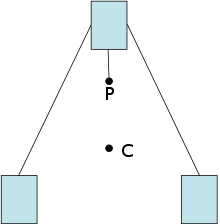

The center of mass is often called the center of gravity because any uniform gravitational field g acts on a system as if the mass M of the system were concentrated at the center of mass R. This is seen in at least two ways:
- The gravitational potential energy of a system is equal to the potential energy of a point particle having the same mass M located at R.
- The gravitational torque on a system equals the torque of a force Mg acting at R:
If the gravitational field acting on a body is not uniform, then the center of mass does not necessarily exhibit these convenient properties concerning gravity. As the situation is put in Feynman's influential textbook The Feynman Lectures on Physics:[citation needed]
- "The center of mass is sometimes called the center of gravity, for the reason that, in many cases, gravity may be considered uniform. ...In case the object is so large that the nonparallelism of the gravitational forces is significant, then the center where one must apply the balancing force is not simple to describe, and it departs slightly from the center of mass. That is why one must distinguish between the center of mass and the center of gravity."
Many authors have been less careful, stating that when gravity is not uniform, "the center of gravity" departs from the CM. This usage seems to imply a well-defined "center of gravity" concept for non-uniform fields. Symon, in his textbook Mechanics, shows that the center of gravity of an extended body must always be defined relative to an external point, at which location resides a point mass that is exerting a gravitational force on the object in question. In fact, as Symon says:
- "For two extended bodies, no unique centers of gravity can in general be defined, even relative to each other, except in special cases, as when the bodies are far apart, or when one of them is a sphere....The general problem of determining the gravitational forces between bodies is usually best treated by means of the concepts of the field theory of gravitation..."
Even when considering tidal forces on planets, it is sufficient to use centers of mass to find the overall motion. In practice, for non-uniform fields, one simply does not speak of a "center of gravity".[3]
[edit] CM frame
The angular momentum vector for a system is equal to the angular momentum of all the particles around the center of mass, plus the angular momentum of the center of mass, as if it were a single particle of mass M:
This is a corollary of the Parallel Axis Theorem.
| This section requires expansion. |
[edit] Engineering
| This section requires expansion. |
[edit] Aeronautical significance
The center of mass is an important point on an aircraft, which significantly affects the stability of the aircraft. To ensure the aircraft is stable enough to be safe to fly, the center of mass must fall within specified limits. This range varies by aircraft to aircraft.
For fixed-wing aircraft, as a rule of thumb, it is centered about a point one quarter of the way from the wing leading edge to the wing trailing edge (the quarter chord point). If the center of mass is ahead of the forward limit, the aircraft will be less maneuverable, possibly to the point of being unable to rotate for takeoff or flare for landing. If the center of mass is behind the aft limit, the aircraft will be more maneuverable, but also less stable, and possibly so unstable that it is impossible to fly. The moment arm of the elevator will also be reduced, which makes it more difficult to recover from a stalled condition.
For helicopters in hover, the center of mass is always directly below the rotorhead. In forward flight, the center of mass will move aft to balance the negative pitch torque produced by applying cyclic control to propel the helicopter forward; consequently a cruising helicopter flies "nose-down" in level flight.
[edit] Barycenter in astrophysics and astronomy
The barycenter (or barycentre; from the Greek βαρύκεντρον) is the point between two objects where they balance each other. For example, it is the center of mass where two or more celestial bodies orbit each other. When a moon orbits a planet, or a planet orbits a star, both bodies are actually orbiting around a point that lies outside the center of the primary (the larger body). For example, the moon does not orbit the exact center of the Earth, but a point on a line between the center of the Earth and the Moon ,approximately 1,710 km below the surface of the Earth, where their respective masses balance. This is the point about which the Earth and Moon orbit as they travel around the Sun.
The barycenter is one of the foci of the elliptical orbit of each body. This is an important concept in the fields of astronomy, astrophysics, and the like (see two-body problem).
In a simple two-body case, r1, the distance from the center of the primary to the barycenter is given by:
where:
- a is the distance between the centers of the two bodies;
- m1 and m2 are the masses of the two bodies.
r1 is essentially the semi-major axis of the primary's orbit around the barycenter—and r2 = a − r1 the semi-major axis of the secondary's orbit. Where the barycenter is located within the more massive body, that body will appear to "wobble" rather than following a discernible orbit.
The following table sets out some examples from our solar system. Figures are given rounded to three significant figures. The last two columns show R1, the radius of the first (more massive) body, and r1/R1, the ratio of the distance to the barycenter and that radius: a value less than one shows that the barycenter lies inside the first body.
| Larger body |
m1 (mE=1) |
Smaller body |
m2 (mE=1) |
a (km) |
r1 (km) |
R1 (km) |
r1/R1 |
|---|---|---|---|---|---|---|---|
| Remarks | |||||||
| Earth | 1 | Moon | 0.0123 | 384,000 | 4,670 | 6,380 | 0.732 |
| The Earth has a perceptible "wobble"; see tides. | |||||||
| Pluto | 0.0021 | Charon | 0.000254 (0.121 mPluto) |
19,600 | 2,110 | 1,150 | 1.83 |
| Both bodies have distinct orbits around the barycenter, and as such Pluto and Charon were considered as a double planet by many before the redefinition of planet in August 2006. | |||||||
| Sun | 333,000 | Earth | 1 | 150,000,000 (1 AU) |
449 | 696,000 | 0.000646 |
| The Sun's wobble is barely perceptible. | |||||||
| Sun | 333,000 | Jupiter | 318 (0.000955 mSun) |
778,000,000 (5.20 AU) |
742,000 | 696,000 | 1.07 |
| The Sun orbits a barycenter just above its surface.[4] | |||||||
If m1 ≫ m2—which is true for the Sun and any planet—then the ratio r1/R1 approximates to:
Hence, the barycenter of the Sun-planet system will lie outside the Sun only if:
That is, where the planet is heavy and far from the Sun.
If Jupiter had Mercury's orbit (57,900,000 km, 0.387 AU), the Sun-Jupiter barycenter would be only 5,500 km from the center of the Sun (r1/R1 ~ 0.08). But even if the Earth had Eris' orbit (68 AU), the Sun-Earth barycenter would still be within the Sun (just over 30,000 km from the center).
To calculate the actual motion of the Sun, you would need to sum all the influences from all the planets, comets, asteroids, etc. of the solar system (see n-body problem). If all the planets were aligned on the same side of the Sun, the combined center of mass would lie about 500,000 km above the Sun's surface.
The calculations above are based on the mean distance between the bodies and yield the mean value r1. But all celestial orbits are elliptical, and the distance between the bodies varies between the apses, depending on the eccentricity, e. Hence, the position of the barycenter varies too, and it is possible in some systems for the barycenter to be sometimes inside and sometimes outside the more massive body. This occurs where:
Note that the Sun-Jupiter system, with eJupiter = 0.0484, just fails to qualify: 1.05 ≯ 1.07 > 0.954.
[edit] Animations
Images are representative (made by hand), not simulated.
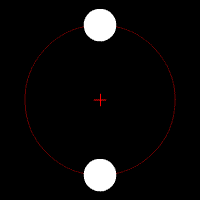 Two bodies of similar mass orbiting a common barycenter. (similar to the 90 Antiope system) |
 Two bodies with a difference in mass orbiting a common barycenter, as in the Pluto–Charon system. |
 Two bodies with a major difference in mass orbiting a common barycenter (similar to the Earth–Moon system) |
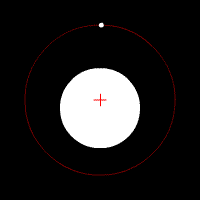 Two bodies with an extreme difference in mass orbiting a common barycenter (similar to the Sun–Earth system) |
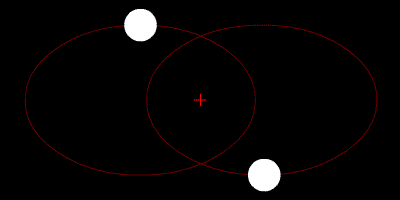 Two bodies with similar mass orbiting a common barycenter with elliptic orbits (a common situation for binary stars) |
|||
[edit] Locating the center of mass
[edit] Of an arbitrary 2D physical shape
This method is useful when one wishes to find the centroid of a complex planar shape with unknown dimensions. It relies on finding the center of mass of a thin body of homogenous density having the same shape as the complex planar shape.
| Step 1: An arbitrary 2D shape. | Step 2: Suspend the shape from a location near an edge. Drop a plumb line and mark on the object. | Step 3: Suspend the shape from another location not too close to the first. Drop a plumb line again and mark. The intersection of the two lines is the center of mass. |
[edit] Of an L-shaped object
This is a method of determining the center of mass of an L-shaped object.
- Divide the shape into two rectangles, as shown in fig 2. Find the center of masses of these two rectangles by drawing the diagonals. Draw a line joining the centers of mass. The center of mass of the shape must lie on this line AB.
- Divide the shape into two other rectangles, as shown in fig 3. Find the centers of mass of these two rectangles by drawing the diagonals. Draw a line joining the centers of mass. The center of mass of the L-shape must lie on this line CD.
- As the center of mass of the shape must lie along AB and also along CD, it is obvious that it is at the intersection of these two lines, at O. (The point O may or may not lie inside the L-shaped object.)
[edit] Of a composite shape
This method is useful when one wishes to find the location of the centroid or center of mass of an object that is easily divided into elementary shapes, whose centers of mass are easy to find (see List of centroids). Here the center of mass will only be found in the x direction. The same procedure may be followed to locate the center of mass in the y direction.
 The shape. It is easily divided into a square, triangle, and circle. Note that the circle will have negative area.
The shape. It is easily divided into a square, triangle, and circle. Note that the circle will have negative area.
 From the List of centroids, we note the coordinates of the individual centroids.
From the List of centroids, we note the coordinates of the individual centroids.
 units.
units.
The center of mass of this figure is at a distance of 8.5 units from the left corner of the figure.
[edit] By tracing around the perimeter of an object
| This section requires expansion. |
A direct development of the planimeter known as an integraph, or integerometer (though a better term is probably moment planimeter), can be used to establish the position of the centroid or center of mass of an irregular shape. This method can be applied to a shape with an irregular, smooth or complex boundary where other methods are too difficult. It was regularly used by ship builders to ensure the ship would not capsize. See Locating the center of mass by mechanical means.
[edit] See also
- Center of gravity of an aircraft
- Center of percussion
- Center of pressure
- Mass point geometry
- Metacentric height
- Roll center
- Two-body problem
- n-body problem
- Weight distribution
[edit] Notes
- ^ Van Pelt, Michael (2005). Space Tourism: Adventures in Earth Orbit and Beyond. Springer. pp. 185. ISBN 0387402136.
- ^ Giambattista, Alan; McCarthy Richardson, Betty; Coleman Richardson, Robert (2007), College physics, Volume 1 (2 ed.), McGraw-Hill Higher Education, p. 235, ISBN 0-071-10608-1, http://books.google.com/books?ei=qLuyTP6IL8OfOv6H6e0F
- ^ Symon, K. R. (1971). Mechanics, 3rd ed., Reading: Addison-Wesley.[citation needed]
- ^ "What's a Barycenter?". Space Place @ NASA. 2005-09-08. http://spaceplace.nasa.gov/en/kids/barycntr.shtml. Retrieved 2011-01-20.
[edit] References
- Feynman, Richard; Robert Leighton, Matthew Sands (1963). The Feynman Lectures on Physics. Addison Wesley. ISBN 0-201-02116-1.
- Goldstein, Herbert; Charles Poole, John Safko (2002). Classical Mechanics (3e ed.). Addison Wesley. ISBN 0-201-65702-3.
- Kleppner, Daniel; Robert Kolenkow (1973). An Introduction to Mechanics (2e ed.). McGraw-Hill. ISBN 0-07-035048-5.
- Marion, Jerry; Stephen Thornton (1995). Classical Dynamics of Particles and Systems (4e ed.). Harcourt. ISBN 0-03-097302-3.
- Murray, Carl; Stanley Dermott (1999). Solar System Dynamics. Cambridge UP. ISBN 0-521-57295-9.
- Serway, Raymond A.; Jewett, John W. (2004). Physics for Scientists and Engineers (6th ed.). Brooks/Cole. ISBN 0-534-40842-7.
- Symon, Keithe R. (1971). Mechanics (3rd edition ed.). Addison-Wesley. ISBN 0-201-07392-7.
- Tipler, Paul (2004). Physics for Scientists and Engineers: Mechanics, Oscillations and Waves, Thermodynamics (5th ed.). W. H. Freeman. ISBN 0-7167-0809-4.
[edit] External links
| Look up barycentre in Wiktionary, the free dictionary. |
- Center of Gravity Encyclopædia Britannica.
- Locating the center of mass by mechanical means.
- The dynamic centre of gravity Engineer Xavier Borg - Blaze Labs Research
- Motion of the Center of Mass shows that the motion of the center of mass of an object in free fall is the same as the motion of a point object.
- The solar system's barycenter Simulations showing the effect each planet contributes to the solar system's barycenter
- Polygon Center of Mass An algorithm that would calculate the center of mass of a polygonal figure consisting of n points (x, y).
|
||||||||
























